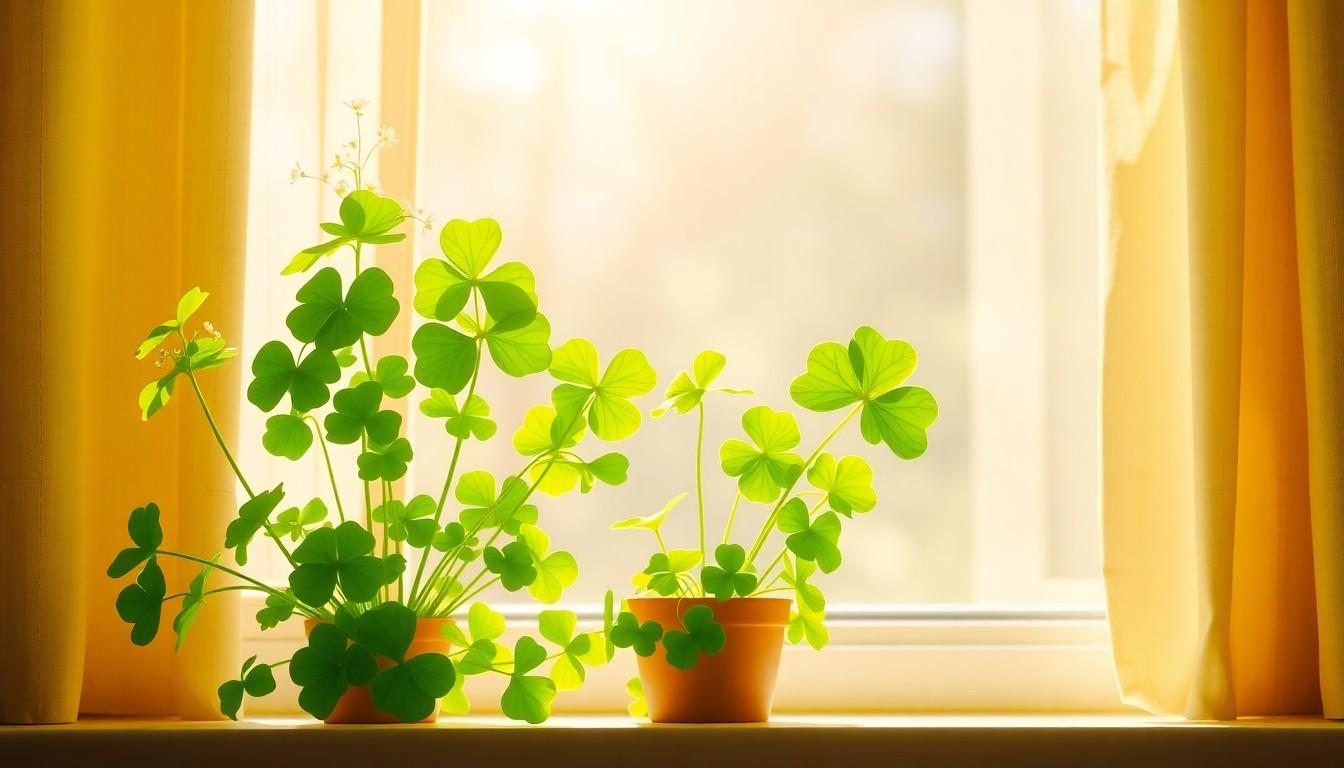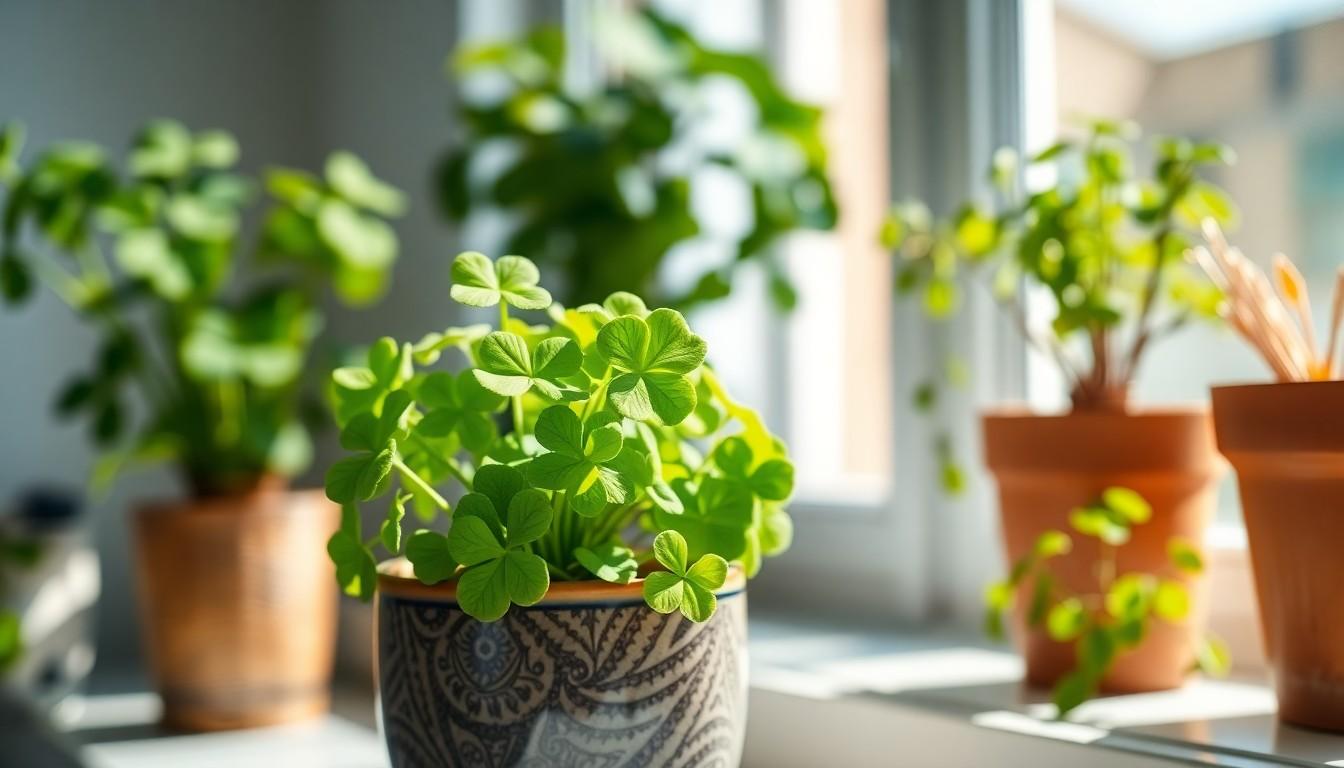Physical Address
304 North Cardinal St.
Dorchester Center, MA 02124

Shamrock plants are like the charming little leprechauns of the plant world—full of personality and a touch of whimsy. With their vibrant green leaves and delicate white or purple flowers, they bring a sprinkle of luck to any space. But don’t let their enchanting looks fool you; these plants have specific needs to thrive.
Shamrock plants, often recognized for their trifoliate leaves, fall into the oxalis family. They’re popular houseplants due to their striking appearance and cultural significance, often associated with good fortune. This plant typically showcases vibrant green foliage that may feature a hint of purple on some varieties. Flowering occurs in spring, presenting delicate white or pink blossoms that enhance its visual allure.
Cultivating a shamrock plant requires attention to specific care needs. Adequate sunlight is essential, as these plants thrive in bright, indirect light. Leaf dropping may occur if they’re exposed to direct sunlight for prolonged periods. Soil moisture plays a critical role in their health; a well-draining potting mix prevents root rot.
Temperature range also impacts shamrock growth. Ideal conditions exist between 60°F and 75°F, with significant drops stressing the plant. During the dormancy phase, usually in late summer or early fall, watering should decrease, allowing the plant to rest.
Propagation provides an easy route to expanding a shamrock collection. Rhizome division serves as a common method, ensuring healthy new plants. Fertilization occurs during the growing season using a balanced liquid fertilizer, promoting robust growth and vibrant foliage.
Pest control might become necessary as aphids or mealybugs can sometimes invade. Regular inspection helps to catch infestations before they spread. Healthy shamrock plants often thrive without issues, making them a delightful addition to any indoor space.

Shamrock plants require specific conditions for optimal growth. Understanding these preferences sets the foundation for successful cultivation.
Well-draining soil is crucial for shamrock plants. A potting mix enriched with organic matter promotes proper moisture retention while preventing root rot. Use a mixture that includes peat moss or perlite for ideal aeration. Regularly checking for compacted soil ensures healthy root development.
Bright, indirect light enhances the growth of shamrock plants. Too much direct sunlight can lead to leaf drop or sunburn. Placing them near a window with filtered light offers an excellent balance. During shorter days in winter, using supplemental artificial light supports continued growth without stressing the plant.
Temperatures ranging from 60°F to 75°F are ideal for shamrock plants. These conditions encourage vibrant foliage and flower production. Humidity levels around 40 to 60 percent contribute to overall health. Regular misting can help raise humidity; however, ensure adequate air circulation to prevent mold.
Watering techniques play a vital role in the overall health of shamrock plants. Maintaining proper moisture levels ensures lush foliage and vibrant blooms.
Watering frequency depends on various factors, including environment and season. Typically, shamrock plants require watering when the top inch of soil feels dry. During active growth, which occurs in spring, every 5 to 7 days may suffice. In contrast, watering becomes less frequent during dormancy in late summer, potentially extending to every 2 to 3 weeks. It’s crucial to avoid letting the plant sit in water to prevent root rot. Checking soil moisture regularly promotes optimal hydration.
Signs of overwatering often manifest as yellowing leaves and mushy stems. Leaf drop may follow, suggesting the plant receives too much water. Conversely, underwatering might result in wilting leaves and dry, crispy edges. When leaves appear dull or shriveled, the plant likely needs hydration. Regular observation assists in identifying these symptoms early and enables prompt adjustment. By responding to these signs, one ensures the shamrock plant thrives effectively.
Fertilizing a shamrock plant supports its growth and vibrant foliage. Proper practices ensure nutrient availability throughout the growing season.
Balanced liquid fertilizers work best for shamrock plants, providing essential nutrients. Look for options with equal ratios of nitrogen, phosphorus, and potassium, such as a 10-10-10 formulation. Organic fertilizers such as fish emulsion can enhance soil quality and promote healthy root development. Additionally, seaweed extract offers trace nutrients and improves overall plant resilience. Many gardeners favor slow-release fertilizers, allowing nutrients to be gradually absorbed over time.
Fertilization occurs primarily during the growing season, spanning spring to early summer. Apply fertilizer every four to six weeks to maintain optimal health. Dilute the liquid fertilizer to half-strength, preventing potential burn from high concentrations. Timing is crucial; fertilization should occur after watering to avoid stressing the roots. During the dormancy phase, which begins in late summer, cease fertilizing until new growth resumes. Following these guidelines keeps the shamrock plant thriving and lush.
Shamrock plants can encounter various pests and diseases that affect their growth and appearance. Identifying these issues early is crucial for effective management.
Common pests include aphids and mealybugs, which can inhabit the foliage. Look for clusters of small insects or a sticky substance on leaves, signaling an invasion. Noticeable yellowing of leaves may indicate pest damage. Discolored spots or webbing can also suggest spider mites, a less common but concerning pest. Regular checks for these signs ensure quicker action against infestations.
Preventing pests begins with maintaining good air circulation around shamrock plants. Placing the plants away from heavily infested areas reduces risks. Regularly cleaning leaves with a damp cloth removes dust and potential pests. If an infestation occurs, treating with insecticidal soap or neem oil minimizes damage while being safe for the plant. Repeating treatments every few days helps eradicate pests effectively. Monitoring the plant’s overall health promotes resilience against both pests and diseases, ensuring long-term vitality.
Caring for a shamrock plant can be a rewarding experience. With the right attention to light, water, and humidity levels, these charming plants can thrive beautifully in any indoor space. Regular monitoring for pests and adjusting care routines during dormancy ensures their health and vibrancy.
By following the outlined care tips, anyone can enjoy the whimsical beauty and cultural significance of shamrock plants. Their unique trifoliate leaves and delicate blossoms not only enhance home decor but also bring a touch of luck. Embracing the joy of nurturing these plants can lead to a lush and vibrant addition to any collection.